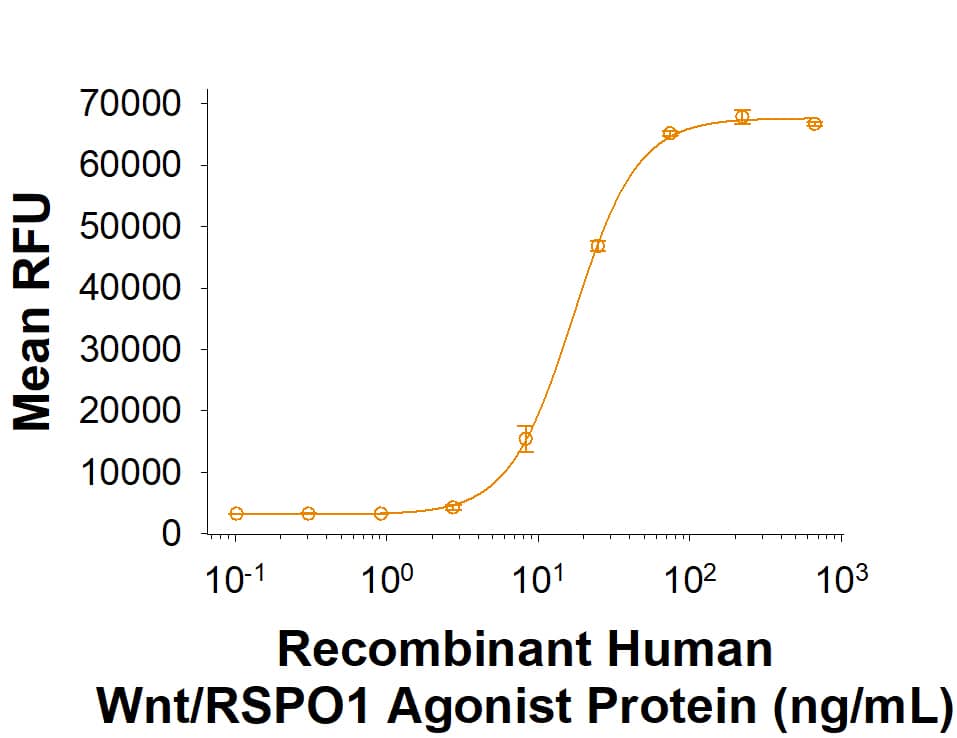Mouse DPPA4 Antibody Summary
Asn125-Gly296
Accession # Q8CCG4
Customers also Viewed
Applications
Please Note: Optimal dilutions should be determined by each laboratory for each application. General Protocols are available in the Technical Information section on our website.
Scientific Data
 View Larger
View Larger
DPPA4 in D3 Mouse Cell Line. DPPA4 was detected in immersion fixed D3 mouse embryonic stem cell line using Goat Anti-Mouse DPPA4 Antigen Affinity-purified Polyclonal Antibody (Catalog # AF3730) at 10 µg/mL for 3 hours at room temperature. Cells were stained using the NorthernLights™ 493-conjugated Anti-Goat IgG Secondary Antibody (green; Catalog # NL003) and counterstained with DAPI (blue). Specific staining was localized to nuclei. View our protocol for Fluorescent ICC Staining of Cells on Coverslips.
Preparation and Storage
- 12 months from date of receipt, -20 to -70 °C as supplied.
- 1 month, 2 to 8 °C under sterile conditions after reconstitution.
- 6 months, -20 to -70 °C under sterile conditions after reconstitution.
Background: DPPA4
DPPA4 is a 33 kDa molecule that is expressed specifically in the early embryo, uncommitted cells of the germ line, and embryonic stem cells and is used as a marker of pluripotent cells. Mouse DPPA4 is 296 amino acids in length and contains an SAP (SAF-A/B, ACINUS, PIAS) putative DNA-binding domain. Two potential isoforms exist with deletions of amino acids 104‑120 and 69‑120, respectively. In the region used as an immunogen, mouse DPPA4 shows 57% amino acid sequence identity with human and 87% identity with rat DPPA4 proteins.
Product Datasheets
Citations for Mouse DPPA4 Antibody
R&D Systems personnel manually curate a database that contains references using R&D Systems products. The data collected includes not only links to publications in PubMed, but also provides information about sample types, species, and experimental conditions.
13
Citations: Showing 1 - 10
Filter your results:
Filter by:
-
Lesion environments direct transplanted neural progenitors towards a wound repair astroglial phenotype in mice
Authors: O'Shea TM, Ao Y, Wang S et al.
Nature Communications
-
Mitotic Arrest in Teratoma Susceptible Fetal Male Germ Cells
Authors: Patrick S. Western, Rachael A. Ralli, Stephanie I. Wakeling, Camden Lo, Jocelyn A. van den Bergen, Denise C. Miles et al.
PLoS ONE
-
Multimodal characterization of murine gastruloid development
Authors: Simon Suppinger, Marietta Zinner, Nadim Aizarani, Ilya Lukonin, Raphael Ortiz, Chiara Azzi et al.
Cell Stem Cell
-
Lesion environments direct transplanted neural progenitors towards a wound repair astroglial phenotype in mice
Authors: O'Shea TM, Ao Y, Wang S et al.
Nature Communications
-
Extensive SUMO Modification of Repressive Chromatin Factors Distinguishes Pluripotent from Somatic Cells
Authors: I Theurillat, IA Hendriks, JC Cossec, A Andrieux, ML Nielsen, A Dejean
Cell Rep, 2020-09-15;32(11):108146.
Species: Mouse
Sample Types: Cell Lysates
Applications: Western Blot -
Tox4 modulates cell fate reprogramming
Authors: L Vanheer, J Song, N De Geest, A Janiszewsk, I Talon, C Provenzano, T Oh, J Chappell, V Pasque
J. Cell. Sci., 2019-10-22;0(0):.
Species: Mouse
Sample Types: Whole Cells
Applications: ICC -
Reduced PRC2 function alters male germline epigenetic programming and paternal inheritance
Authors: JM Stringer, SC Forster, Z Qu, L Prokopuk, MK O'Bryan, DK Gardner, SJ White, D Adelson, PS Western
BMC Biol., 2018-09-20;16(1):104.
Species: Mouse
Sample Types: Whole Tissue
Applications: IHC -
Genomic functions of developmental pluripotency associated factor 4 (Dppa4) in pluripotent stem cells and cancer
Authors: RH Klein, PY Tung, P Somanath, HJ Fehling, PS Knoepfler
Stem Cell Res, 2018-07-19;31(0):83-94.
Species: Mouse
Sample Types: Protein
Applications: ChIP -
Esrrb Unlocks Silenced Enhancers for Reprogramming to Naive Pluripotency
Authors: K Adachi, W Kopp, G Wu, S Heising, B Greber, M Stehling, MJ Araúzo-Bra, ST Boerno, B Timmermann, M Vingron, HR Schöler
Cell Stem Cell, 2018-06-14;0(0):.
Species: Mouse
Sample Types: Whole Cells
Applications: IHC -
Hybrid Cellular Metabolism Coordinated by Zic3 and Esrrb Synergistically Enhances Induction of Naive Pluripotency
Authors: M Sone, N Morone, T Nakamura, A Tanaka, K Okita, K Woltjen, M Nakagawa, JE Heuser, Y Yamada, S Yamanaka, T Yamamoto
Cell Metab., 2017-05-02;25(5):1103-1117.e6.
Species: Mouse
Sample Types: Whole Cells
Applications: ICC -
Identification of DPPA4 and DPPA2 as a novel family of pluripotency-related oncogenes.
Authors: Tung P, Varlakhanova N, Knoepfler P
Stem Cells, 2013-11-01;31(11):2330-42.
Species: Mouse
Sample Types: Cell Lysates
Applications: ChIP -
Maternal Dppa2 and Dppa4 are dispensable for zygotic genome activation but important for offspring survival
Authors: Oana Kubinyecz, Fatima Santos, Deborah Drage, Wolf Reik, Melanie A. Eckersley-Maslin
Development
-
Signaling through the TGF Beta-Activin Receptors ALK4/5/7 Regulates Testis Formation and Male Germ Cell Development
Authors: Denise C. Miles, Stephanie I. Wakeling, Jessica M. Stringer, Jocelyn A. van den Bergen, Dagmar Wilhelm, Andrew H. Sinclair et al.
PLoS ONE
FAQs
No product specific FAQs exist for this product, however you may
View all Antibody FAQsIsotype Controls
Reconstitution Buffers
Secondary Antibodies
Reviews for Mouse DPPA4 Antibody
Average Rating: 5 (Based on 1 Review)
Have you used Mouse DPPA4 Antibody?
Submit a review and receive an Amazon gift card.
$25/€18/£15/$25CAN/¥75 Yuan/¥2500 Yen for a review with an image
$10/€7/£6/$10 CAD/¥70 Yuan/¥1110 Yen for a review without an image
Filter by:

















